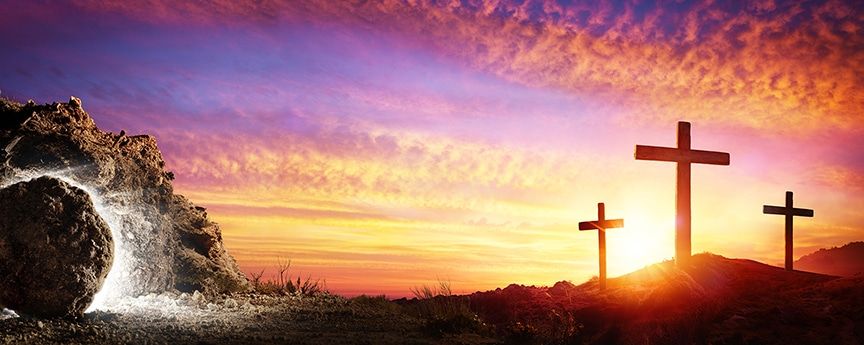Resurrection in the Gospels

All resurrection promises in the Old Testament are centered in the coming of the Redeemer, the Savior, the Messiah. Without the coming of Christ, all those in the Old Testament who died in faith would have died in vain. Likewise, without the resurrection of Jesus Christ from the grave, the hope of all Christians for eternal life would be in vain. Paul forthrightly declared the necessity of the literal resurrection of the body of Christ from the grave in 1 Corinthians 15:13–14: “But if there be no resurrection of the dead, then is Christ not risen: And if Christ be not risen, then is our preaching vain, and your faith is also vain.”
Jesus Christ declared Himself to be the only hope of mankind in a literal resurrection. He said, as recorded in John 11:25–26: “… I am the resurrection, and the life: he that believeth in me, though he were dead, yet shall he live: And whosoever liveth and believeth in me shall never die. …”
When Jesus was born of the virgin Mary, the nation of Israel was divided into three main groups: the Sadducees, the Pharisees, and the lower class. The Sadducees were the upper class, composed mostly of the wealthy—the landowners and the richer merchants. The Sadducees were mostly agnostic in their belief toward God. Even some of the higher priests were included within the membership of this sect. The Sadducees’ heaven was here on earth, and they denied the existence of angels, a future life, and the resurrection. We read in Matthew 22:23: “The same day came to him the Sadducees, which say that there is no resurrection. …”
The second division of Israel according to theology was the Pharisees. The Pharisees were of the middle class. They were very patriotic and prided themselves on being keepers of the law and traditions of Israel. Being students of the Scriptures, they stoutly believed in the resurrection of the dead. Because they believed in the resurrection, some of the Pharisees became disciples of Jesus when He demonstrated His power over death in the raising of the dead. However, the majority of the Pharisees rejected Jesus as the promised Messiah, and it was their influence over the people that led to the crucifixion of Jesus Christ.
The lower class, which comprised the vast majority of Israel at that time, were too busy earning their daily bread to become involved in politics or religion. Most of them were honest, hard-working people, who did the best they could to provide for their families, honor the law, worship God, and go up to Jerusalem at least once a year at the time of Passover. It was from the lower class that Jesus won most of His disciples.
Because all the Old Testament teachings on resurrection looked forward to the coming of the Messiah, the miracles of Jesus in the raising of the dead and His teachings on this subject comprised an important part of His earthly ministry. His declaration that He was the resurrection and the life was followed by a visible demonstration to prove that He was the Redeemer who had come to raise the dead. After Jesus professed to Martha that He was the one who was sent by God to bring the dead back to life, we read the account of what happened next in John 11:41–46:
Then they took away the stone from the place where the dead was laid. And Jesus lifted up his eyes, and said, Father, I thank thee that thou hast heard me. And I knew that thou hearest me always: but because of the people which stand by I said it, that they may believe that thou hast sent me. And when he thus had spoken, he cried with a loud voice, Lazarus, come forth. And he that was dead came forth, bound hand and foot with graveclothes: and his face was bound about with a napkin. Jesus saith unto them, Loose him, and let him go. Then many of the Jews which came to Mary, and had seen the things which Jesus did, believed on him. But some of them went their ways to the Pharisees, and told them what things Jesus had done.
Lazarus had been dead for several days, and his body already was in the process of decaying. Yet Jesus restored the soul and the spirit to the body, and the dead man lived. Another account of Jesus raising the dead is recorded in Luke 8:49–56, where the Lord restored to life the dead body of Jairus’ daughter. However, these miracles in raising the dead were mere signs of Christ’s power over death, and not literal demonstrations of resurrection. Neither the daughter of Jairus nor Lazarus was raised in a glorified body. It is evident from Scripture that they lived out their normal life span, and then died a natural death. We read in 1 Corinthians 15:21–23: “For since by man came death, by man came also the resurrection of the dead. For as in Adam all die, even so in Christ shall all be made alive. But every man in his own order: Christ the firstfruits; afterward they that are Christ’s at his coming.”
Jesus Christ was the first to be raised in an incorruptible and immortal body. There will be no other person raised in a glorified body until Christ’s return. Many Christians are concerned about what happened in Matthew 27:50–54:
Jesus, when he had cried again with a loud voice, yielded up the ghost. And, behold, the veil of the temple was rent in twain from the top to the bottom; and the earth did quake, and the rocks rent; And the graves were opened; and many bodies of the saints which slept arose, And came out of the graves after his resurrection, and went into the holy city, and appeared unto many. Now when the centurion, and they that were with him, watching Jesus, saw the earthquake, and those things that were done, they feared greatly, saying, Truly this was the Son of God.
Jesus Christ was resurrected in a glorified body, but Matthew does not call the appearance of the saints in a body a resurrection. This probably was a localized miracle for the benefit of Israel, to again prove to the Jews that Jesus Christ was the Son of God, the promised Messiah. Not all the saints arose—only some in the graveyard in the vicinity of Jerusalem. This miracle is recorded only in Matthew, indicating that it was a sign to the Jews, and it is nowhere else mentioned in the Bible. What happened to the bodies of the saints that arose after the resurrection of Jesus and appeared to many in Jerusalem is not known. It is not necessary that we do know. Inasmuch as Jesus Christ has the power to restore a dead, decaying body to life, He could have brought the bodies of the saints in the graveyard at Jerusalem back to life for five minutes, an hour, a day, or whatever length of time it was needed to prove that He had risen with the power of resurrection over all death. This particular incident was another miracle to show Israel that if the nation would receive Jesus as Messiah, all the saints would be resurrected, and the promised Kingdom would be brought in at that time.
It is usually interpreted that Paul meant in 1 Corinthians 13:13 that the saved will be known in Heaven even as they are known on earth. But what identifies the individual? Is it outward physical appearance, or the personality? Is our physical appearance our identity, or do what we think, how we act, what we say, and our feelings and emotions identify us more? Man looks on the outward appearance, but God looks upon the inward man. The Scriptures say that the resurrection body will be a spiritual body—we will be known by our spiritual identity more than our physical appearance.
The Old Testament teaching concerning the resurrection of both the just and the unjust was verified by Jesus in John 5:28-29. But the greatest teaching on the resurrection by Jesus was by and through His own resurrection. He predicted that He would die and be raised again. We read His words in Matthew 12:40: “For as Jonas was three days and three nights in the whale’s belly; so shall the Son of man be three days and three nights in the heart of the earth.”
He arose again the third day to prove to man that there was a resurrection from the dead, and He said in John 14:19, “… because I live, ye shall live also.” He was seen of above five hundred witnesses. God raised Him up to prove to the world that He had offered a payment for sins, that through faith in Him men could be raised in a glorified body and stand before the Creator. It was the resurrection of Jesus Christ that inspired the greatest message to moral man ever written:
So when this corruptible shall have put on incorruption, and this mortal shall have put on immortality, then shall be brought to pass the saying that is written, Death is swallowed up in victory. O death, where is thy sting? O grave, where is thy victory? The sting of death is sin; and the strength of sin is the law. But thanks be to God, which giveth us the victory through our Lord Jesus Christ.Therefore, my beloved brethren, be ye stedfast, unmoveable, always abounding in the work of the Lord, forasmuch as ye know that your labour is not in vain in the Lord.
—1 Corinthians 15:54–58
More from Prophecy in the News Magazine
This site uses Akismet to reduce spam. Learn how your comment data is processed.




Leave a Reply